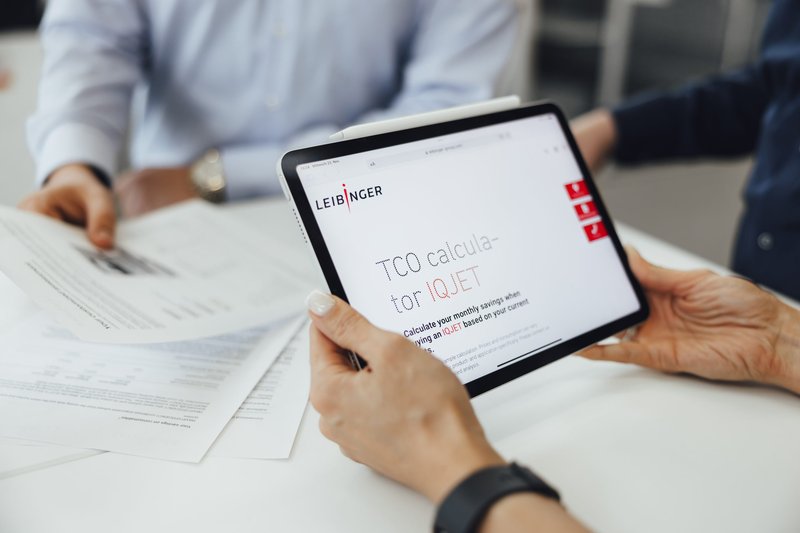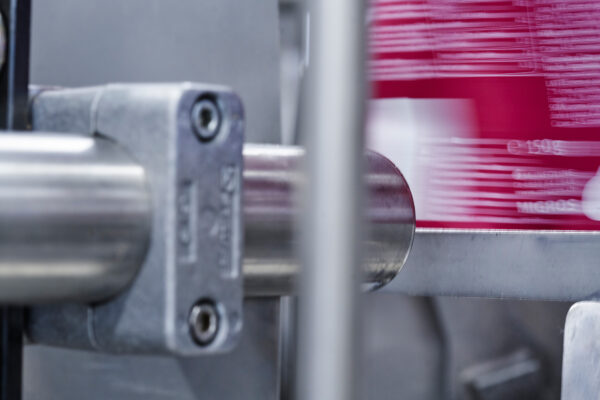 With the LEIBINGER Total Cost of
Ownership Calculator, manufacturers can
identify hidden costs and calculate their
individual savings.
Source: Paul Leibinger GmbH & Co. KG
With the LEIBINGER Total Cost of
Ownership Calculator, manufacturers can
identify hidden costs and calculate their
individual savings.
Source: Paul Leibinger GmbH & Co. KG The hidden costs of industrial printing and how to reduce them
Identify hidden costs in two minutes with the total-cost-of-ownership-calculator
How much do the printers you use on your production line cost? What we mean is, how much do they cost? As the pressure increases on producers and packagers to make their production lines more efficient, we are often asked about how our customers can reduce their printing costs. And the answer we give often surprises them.
Here are six ways that your printers cost money and how to reduce your total cost. Not only that – you will also get access to our new TCO calculator, which will give you an actual figure personalized to you and your business. So where is all that money going?
1. Downtime

Avoid downtime: according to Senseye’s True Cost of owntime Report, the cost of a lost hour ranges from USD 39,000 in the FMCG sector to more than USD 2 million in the automotive sector. Source: Paul Leibinger GmbH & Co. KG
This is the cost that is most often overlooked when talking about coding & marking. Downtime can be created by poor print quality as well as by poor printer performance. Some conventional printers need cleaning between pauses in production. So, the production line sits idle while someone takes the printer through the cleaning cycle. Some printers can take up to 20 minutes to stabilize before they are ready to print again. This delay costs money: according to Senseye’s True Cost of Downtime Report, the cost of a lost hour ranges from USD 39,000 in the FMCG sector to more than USD 2 million in the automotive sector.
With LEIBINGER, this is not a cost you need to worry about. The LEIBINGER printer technology keeps unused ink in a 100% airtight system. It doesn’t dry out or clog, production schedules are not held up for cleaning, and no precious production time and money is wasted. High-quality printing results are guaranteed at any time.
2. Maintenance
It’s important to keep machines serviced and in good working order, and this can be a significant part of the overall cost unless you have a LEIBINGER IQJET. The IQJET is maintenance-free for five years. This is possible because we use durable, high-quality components and a unique product design that minimizes ‘wear and tear’ (e.g. no need for a continuously running feed pump). And it removes the maintenance cost altogether.
In contrast many of the other prominent printing solution providers today seem to lack a crucial focus on minimizing parts and maintenance requirements, as their approach revolves around the wholesale replacement of entire ink core modules, which means the entire hydraulic system, at predetermined time intervals such as annually or biennially. Typically, this process is governed by timeout chips, leading to automatic printer shutdowns when these intervals expire. Consequently, this enforced printer downtime results in production halts for manufacturers. This approach not only lacks sustainability but also incurs exorbitant costs. We are not merely referring to the substantial expenses incurred in replacing ink core modules, which are up to USD 1.500 per year; Downtime costs, in terms of lost production, are equally significant.
Therefore, the query regarding maintenance and spare parts policies should be one of the primary questions to ask your coding and printing solutions provider, as it can constitute a significant long-term cost factor.
3. Labor
Given the current labor shortage, it is particularly important to consider the time cost of people. How long do operators spend setting up or cleaning printers? Or re-programming them between jobs? What is the expected timeframe for commissioning and installation at the facility? Printers that are easy to install, manage, configure, and with remote control options. For example, staff don’t have to walk miles around the plant to operate them will cost less in the long run. Such features are included in LEIBINGER printers. The Plug & Print performance of IQJET is unparalleled in the global market. The drag-and-drop interface and the simplest print job creation process are not only effortless but also highly intuitive, and no extensive training of employees is required.
4. The purchase price
The most obvious cost of printing is the upfront cost of equipment, although this is typically less than 30% of the total costs. As with everything, a high-quality, reliable brand will cost more than a cheaper one. And of course, printers cost more if they go faster or provide more features – so the best way to economize is to ensure you don’t pay for features or speeds that you don’t need. In the long term, the best bet is a reputable supplier with a wide range so you can find a price point that suits you.
5. Consumables

The hidden costs of industrial printing are higher than most manufacturers think. Source: Paul Leibinger GmbH & Co. KG
Reduce the amount of ink and solvent you use, and reduce your costs.Not all printers perform equally. LEIBINGERs latest printers have one of the lowest consumption ratings on the market, 2.7 ml per hour of solvent for MEK inks (competing products typically consume between 6 and 10 ml per hour), and we make sure that ink cartridges are emptied down to the last drop and do not require separate disposal (unlike many conventional CIJ systems). So, you pay less for your consumables.
6. Power
Energy prices remain high, so the power required to run your printers is an important factor. Not only does it cost money, but it also contributes to your organization’s carbon footprint. Choose equipment with a low wattage rating, such as our new IQJET: drawing only 36W it costs less than any other printer to run.
Show me the money!
While it is useful to know the different ways that your printers cost money, you need to see the numbers. You need to know exactly how much you’re paying and how much could you save.
And with our online Total Cost of Ownership Calculator, you can have those numbers in about two minutes.
Check out the Total Cost of Ownership Calculator now.
About the Author:
About Paul Leibinger GmbH & Co. KG (LEIBINGER) LEIBINGER is a globally operating specialist in coding & marking systems with headquarters in Tuttlingen, Baden-Württemberg (Germany). The third-generation family-run company, founded in 1948, develops and produces industrial inkjet printers as well as inks for various applications – with a workforce of close to 300. Innovative technologies and an exceptionally high standard of quality are what distinguish LEIBINGER’s advanced coding & marking solutions. As the inventor of a disruptive nozzle sealing technology
LEIBINGER is transforming the industry’s experience working with Continuous Ink Jet (CIJ), leading to greater productivity in the manufacturing of food and industrial products – with tens of thousands of successful installations worldwide. A global network with some 150 distribution partners and subsidiaries in the US and China ensures that LEIBINGER is ideally positioned to maintain close relationships with its many customers worldwide.









